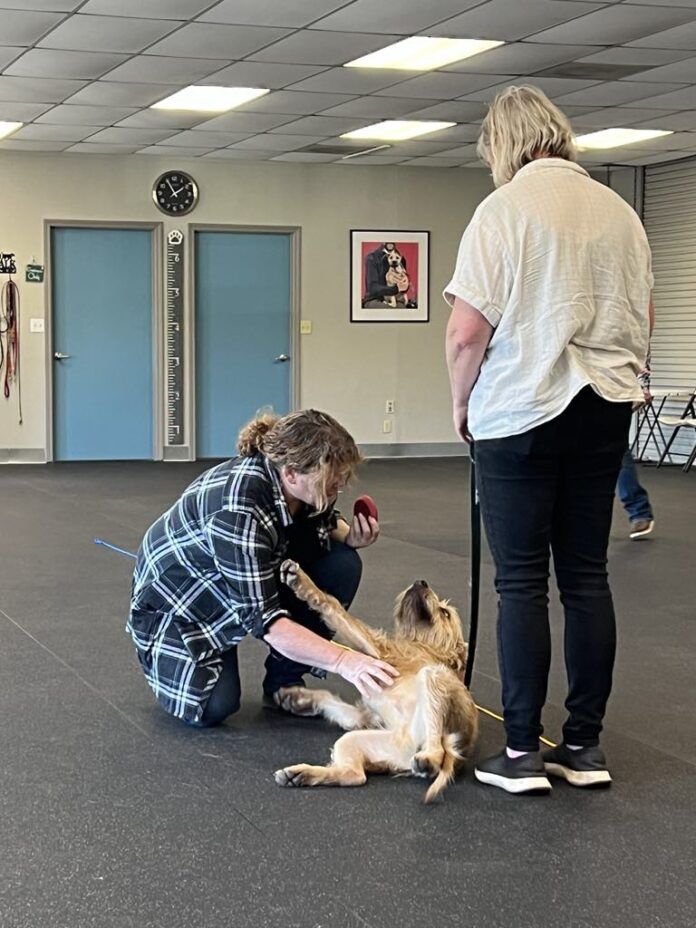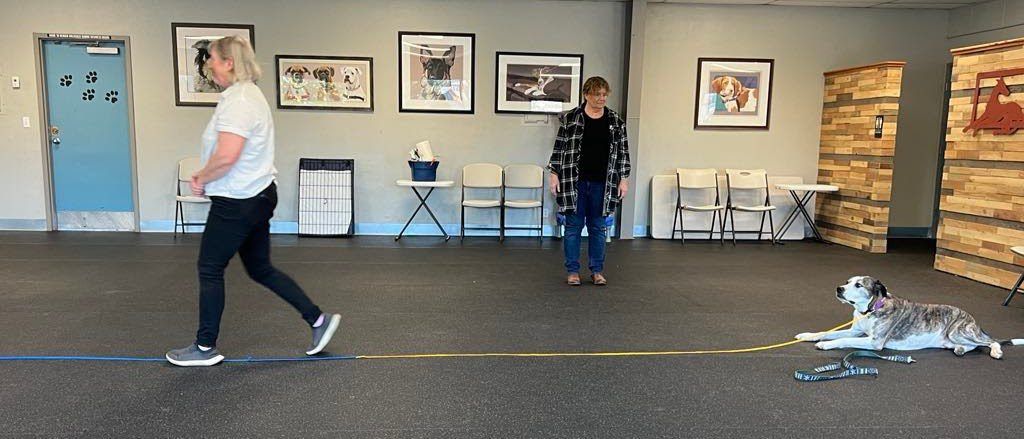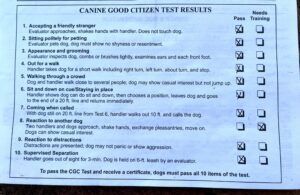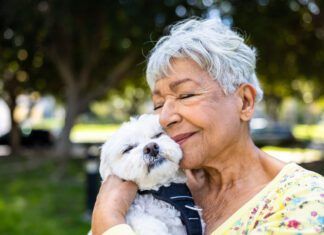
I have been aware of the American Kennel Club’s Canine Good Citizen program for ages, and I always imagined that my dogs would rather easily pass the test. After all, I’ve put hundreds of hours into training them and consider them to be very friendly, well trained, and well-mannered.
An opportunity arose to take the test at my friend’s training center and I thought, “What the heck? Let’s get a title on these mutts!” Never mind that I opted for this opportunity two days before the test.
However, once I started looking over the specific behaviors to be tested, I identified two items that were likely to be our Achilles heel:
In the first, “Accepting a friendly stranger,” your dog is supposed to stay more or less still—at least, not move toward a person who approaches you and your dog and then greets you. If the dog steps in front of you to greet the person, he flunks, even if he is calm and doesn’t jump and isn’t unfriendly; he’s supposed to remain at your side. Shoot; both of my dogs are super friendly and very likely to move toward a person who greets me, if only to sniff their shoes and solicit petting.

In the second, the setup is essentially the same. You walk forward with your dog in a heel position, and a person walks toward you with their dog in a heel position; then both handlers stop and have a brief interaction. Both dogs are on the outside (as if passengers in the passenger seat of a car, with “drivers” stopped and talking to each other out the driver’s window). Your dog is not permitted to cross in front of you—either to greet, sniff, or menace the other person or their dog. I did think my dogs would be able to ignore the other dog, but again, I thought that it was likely that they would want to sniff or greet the other human. I was right about the test items that would be hardest for my dogs, but not the specific part of each challenge.
We practiced this behavior for, oh, at least two minutes apiece, in front of the training center right before the test. And guess what? That’s not enough practice time!

The results for both dogs (and me!) were identical; they flunked on the same item, “Reaction to Another Dog,” though I thought they would easily ignore the dog and be focused more on greeting the human. However, though they both displayed a brief interest in the human (whom, with prompting, they were able to keep themselves from greeting in the first test item (“Accepting a Friendly Stranger”), and happily got to know in item 2 (“Sitting Politely for Petting”) and #3 (Appearance and Grooming,” where the evaluator brushes the dog and examines his ears and each front foot), they both took too much interest in the other dog. Despite more prompting (my repeated use of the “Off!” cue), both stepped in front of me in an attempt to sniff or greet the other dog. Womp, womp, that’s a fail, even if they didn’t pull hard, leap about, or growl. They were supposed to stay at my side, and despite being cued to “Stay,” and “Off” (same as “Leave it”), they didn’t.
These results were not of great importance to me, but I do feel challenged now to sign up for the next local offering of this test, and actually train and practice for it. Though I feel that the expectations of the test should be within every dog’s easy ability to accomplish, clearly they take a bit more training and practice to pass, even with very well behaved dogs!
Note that at no time did I issue any sort of rebuke, tight leash, or yank of a “correction” to my dogs, even though it’s likely that both of them would have readily heeded my “Off!” cue had I been more intense about it. Passing at any cost wasn’t the point; if I couldn’t get them to pay attention to and perform the desired behaviors for my normal cues and tone, then I need to practice this with them. And the truth is, I so seldom walk them on leash in the presence of strangers and strange dogs that we effectively have only rarely practiced these specific behaviors. Having the expectation of certain behaviors without practicing them is just dumb!
Even though this was a formal test in a controlled and artificial setting, the experience was a great reminder to me that it’s not smart to have expectations of our dogs for behaviors that we don’t specifically practice! We expect them to generalize their knowledge about things (such as “Stay” and “Off”), but if we don’t practice these behaviors in a wide array of conditions, we certainly can’t blame them for failing to demonstrate them under different conditions than the few environments and situations we do practice in.
Boone, Woody, and I will be practicing to ace that CGC as soon as we possibly can.
Do you think you and your dogs could pass this test?






My three year old Labrador Retriever, who I have had since she was 9 weeks old, could not pass this for the same reasons. I love my retriever’s friendliness, but you have inspired me. It’s time to practice this.
No way would my dogs pass this test, and 3 of them are certified therapy dogs who make regular visits. I guess for a formal test, you always have to practice to the test, in spite of being able to handle practical requirements just fine.
Yes I had two dogs that passed this test as well as advance good citizen. My biggest concern was leaving their site even though we had practiced this many times at classes I took them to. They passed it all and went on to be therapy dogs for me.
Good obedience classes with consistent work pays off
Hi, all,
I have been an AKC CGC Evaluator for six years, and those are the exercises that undo many excellently trained dogs! You are not alone! The trainer that I work for always hands out the test worksheet prior to any of her students taking the test. I also provide her with a copy of the evaluator’s rules for pass/fail. The evaluator has the option of allowing one exercise to be repeated if the dog and handler team wishes to do so. The purpose, of course, of a Canine Good Citizen, is to be out among the people of the community without needing the handler’s constant attention on the dog. Some people do not like dogs and would consider a friendly sniff to be an act of aggression. The community is not just made up of “dog people”, so the dog has to be able to completely ignore those people and dogs who have no interest in interacting.
I hope this helps explain why these exercises are necessary in a Canine Good Citizen.
Lin Eney
Hi, It’s Lin Eney again.
Just FYI, the ten exercises do NOT have to be given in any particular order. Next time, you might request that the Reaction to Another Dog be done first, along with the Accepting a Friendly Stranger. The same might be true for Walking Through a Crowd.
After your dog has exhibited perfect restraint, the petting and grooming can take place. This is what I suggest if my first 10 second assessment of the dog and handler indicates that the dog is overly friendly.
Some evaluators may just want to get the thing done, but I want to make the experience as positive as possible, even if that means taking a little more time to do the exercises out of sequence. I’m happy to hear that you are going to try again. No better place to train for this than Lowe’s, Home Depot, or Tractor Supply.
Lin
My 14 year old did pass the CGC test 10 years ago. We’ve done lots of training since in many different areas since then… but I’m not sure she’d pass the test again if we took it today.
I was a CGC evaluator many years ago and only one of my dogs passed the test! He was a brilliant Border Collie and was the easiest dog I ever trained. His other Border Collie fam could never deal with me leaving their sight so there you go.
I just dusted off my training book a few days ago to start with my one year old mini dachshund (who resists training sessions as a whole) and my soon to join Mini Australian Mountain Doodle. High hopes for this one.
Instead I’m looking into being an instructor for Pet Professional Guild’s similar evaluation Program called the Pet Ambassador. Thoughts on differences?
I have had great success with the Good Citizen and the Urban Good Citizen tests with my hounds. Even my rambunctious seven month old, who I told the instructor I was going to pull from the test because he did not seem ready. She encouraged me to go ahead and put him through the test as practice since I had already paid. To my great surprise, he passed with flying colors. I was so sure he would fail, that I asked again if she had the correct dog notes. I’m very proud of that young boy and his accomplishments in his too short life.
Great article. I’ve been teaching CGC (and CGC advanced) classes at an AKC Kennel Club for a couple of years, and am an Evaluator. I recently graduated from the rigorous Karen Pryor Academy Dog Training Professional course, which gave me a new perspective on Teaching CGC (and Beginning Family Dog):
Think about what you want your dog TO DO, not what you don’t want them to do. So, when teaching CGC #8 (Reaction to another dog) or Community Canine or CGC-Advanced (#6 – “Leave it” – food on the floor), I encourage students to keep focused on that (‘Stay’ could work). Especially for CGCA-#6, I encourage them to use ‘with me’ (or something similar) because that’s what you want the dog to do.
I appreciate the guidance from the AKC Evaluator/Participate Guide on CORRECTIONS and remind handlers to smile, relax, praise and talk to their dog: “The Canine Good Citizen Program is a program that encourages owners to have fun with their dogs. Harsh corrections are not permitted in the test and are grounds for dismissal. Throughout the CGC test, Evaluators can encourage handlers to PRAISE and interact with their dogs. If beginning handlers are nervous, they may need to be reminded about the importance of communicating with the dog.” We do not allow leash popping, etc. in our CGC classes.
When I got Diana pawPrints we went to all of the puppy classes and then the training until the very last class because Covid hit. She had her S*T*A*R Puppy certificate but I wanted her to get her CGC so we could then move on to training for her to be a therapy dog. But Covid ended that as well as ending her Nosework/Scentwork career. We got Freyja in the middle of Covid and she has separation anxiety so going to the trials would have been impossible unless I took her with me. Then she would be doing a lot of sitting around while we did our trials. Very boring for her. As Diana got older it was apparent that while she had the temperament for Therapy work she also had some phobias that would impact it. She hates elevators. While she might have been trained out of it or to at least tolerate it, that didn’t seem fair to her. She is sensitive to floor surfaces and for the NACSW trials I had to train her to wear booties in case the floors were marble or polished concrete. She doesn’t like her feet touched. Even I can’t do it. She has white coat syndrome and if we go to the vet I have to sedate her so the vet can do a thorough examination, which will include clipping her nails as the only way it can be done is if she is sedated for a blood draw. There is a reason she is so sensitive about her feet and vets, having to do with a traumatic visit to a different vet that we no longer see. But the aftermath lingers on in her phobias and panic attacks. In the dog park or on the street, she is extremely accepting of people, other dogs and pets and attention. Just don’t touch her feet. So that pretty much put an end to CGC, her career as a therapy dog and her “hobby” in Scentwork/Nosework. Freyja would bomb out on everything. You know Dug from Up? That’s Freyja and she doesn’t even need a squirrel.
I forgot to add to my post: DO PRACTICE STAY WITH THE LONG LINE! You’d be amazed at how many dogs find the attachment of that strange object, smelling of other dogs, distracting and disturbing. 🙂